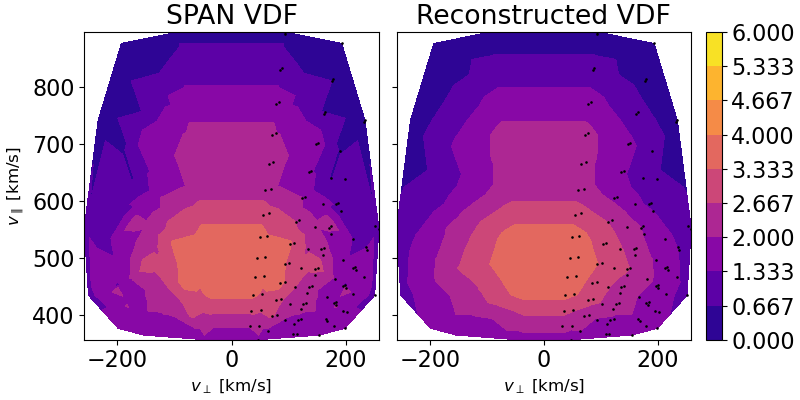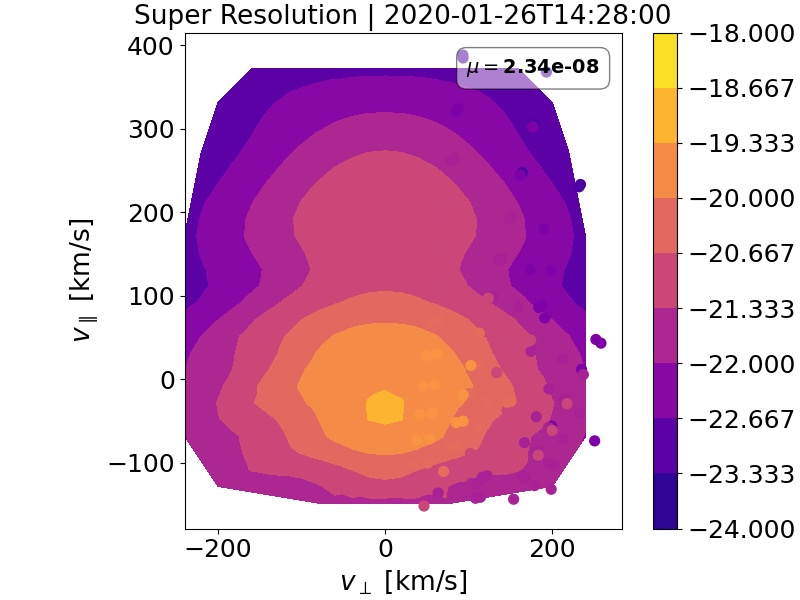Getting started#
The gdf repository directory comes with a main.py driver Python file and a init_gdf_default.py initialization file. It is
expected that the user would only need to change (normally, just a few) of the parameters in the initialization
file to obtain the distributions and associated moments in a desired time interval.
A example GDF reconstruction#
To get started with your first reconstruction using the gdf repository, run the following
in your terminal from the repository directory. Make sure you have activated your environment
where you have installed gdf.
python main.py init_gdf_default
This should generate a few diagnostic figures, plots of reconstruction and super-resolution
under the Figures/ directory, as well as a pkl file under the Outputs/ directory.
Two of these generated figures that we would like to highlight at the outset are
Fig. 1 which shows a comparison between the SPAN-Ai grids in field aligned coordinates (FAC) and the corresponding reconstructed distribution at the same grid points from the polar-cap Slepian reconstruction. These are plotted using
matplotlib.pyplot.tricontourfsince the data is on an irregular grid. This figure can be found inFigures/span_rec_contour/.Fig. 2 which shows the final reconstructed GDF after being super-resolved on a fine Cartesian grid. This figure can be found in
Figures/super_res/. All subsequent moments are computed using super-resolved distributions and not the crude SPAN-Ai FAC distributions.

Fig. 1 Left: A matplotlib.pyplot.tricontourf representation of the SPAN-Ai VDF after rotating the
grids into field aligned coordinates (FAC). Right: Same, but for the polar cap reconstructed GDF
evaluated at the FAC grid locations. The colorbar is obtained from normalizing the log-scaled distributions.#

Fig. 2 Final super-resolved image from the Slepians-on-a-polar-cap basis reconstruction. The
background colormap is obtained from a matplotlib.pyplot.tricontourf of the high-resolution
Cartesian super-resolved grid. The overplotted colored grids denote the SPAN-Ai measurements for
visual comparison to assess goodness-of-fit. The colorbar is in log-scale but in original VDF units.#
Understanding the initialization file#
# init_gdf_default.py
# This is a template for primary initization file.
# 'global': parameters needed for any method of reconstruction
# 'polcap', 'cartesian', 'hybrid' are parameters specific to particular methods of reconstruction
config = {
'global': {
'METHOD' : 'hybrid',
'TRANGE' : ['2020-01-26T14:28:00', '2020-01-26T20:30:59'], # Define the time range to load in from pyspedas
'CLIP' : True,
'START_INDEX' : 0,
'NSTEPS' : 10, # use None for entire TRANGE interval
'CREDS_PATH' : None, # path to the <.json> file containing credentials
'COUNT_THRESHOLD' : 2,
'SAVE_FIGS' : True,
'SAVE_PKL' : True,
'MIN_METHOD' : 'L-BFGS-B',
'NPTS_SUPER' : 49,
'MCMC' : False,
'MCMC_WALKERS' : 6,
'MCMC_STEPS' : 200,
},
'polcap': {
'TH' : 30,
'LMAX' : 12,
'N2D_POLCAP' : None,
'P' : 3,
'SPLINE_MINCOUNT' : 7,
},
'cartesian': {
'N2D_CART' : 16,
},
'hybrid': {
'LAMBDA' : 1e-1,
}
}
The initialization file is supposed to be the primary interface for a standard user. While there are a number of listed parameters, TRANGE, START_INDEX and NTEPS are the three primary parameters which we think the user would interact with the most. Descriptions for all the parameters are provided in the table below.
Parameter |
Type |
Description |
|---|---|---|
TRANGE |
list of str |
Start and end times in ISO 8601 standard format in UTC |
CLIP |
bool |
Whether to clip to specified TRANGE or keep entire day’s data. |
START_INDEX |
int |
Index of first desired time stamp for |
NSTEPS |
int or |
Number of timestamps to analyze starting at START_INDEX. Use |
CREDS_PATH |
str or |
Path to a |
COUNT_THRESHOLD |
int |
Particle count threshold below which grid points are ignored from reconstructions. |
SAVE_FIGS |
bool |
Flag if the final (and diagnostic) figures should be saved under directories in |
SAVE_PKL |
bool |
Flag if the final metadata should be stored as a |
MIN_METHOD |
str |
Minimization method used in the |
NPTS_SUPER |
int or tuple of ints |
Number of super-resolved points in a uniform Cartesian grid of (\(v_{\perp},\, v_{\parallel}\)). This can be a tuple if (NPTSx, NPTSy) where \(x\) is along \(v_{\perp}\) and \(y\) is along \(v_{\parallel}\). |
MCMC |
bool |
Flag to use a MCMC refinement of the gyroaxis, provides error esimtates on the gyro-centroid. |
MCMC_WALKERS |
int |
Number of MCMC walkers to be used. Need to use 3 minimum walkers. |
MCMC_STEPS |
int |
Number of MCMC steps for each walker. Optimal choice: (6 MCMC_WALKERS, 200 MCMC_STEPS). |
TH |
float |
Polar cap extent in degrees about the magnetic field axis used for generating Slepians. |
LMAX |
int |
Maximum angular degree for constructing the 1D Slepian basis on a polar cap.. |
N2D_POLCAP |
int or |
The number of polar-cap Slepian functions to be used for reconstructions. |
P |
int (default: 3) |
The degree of the B-spline used for discretizing in velocity phase space. |
SPLINE_MINCOUNT |
int |
Minimum number of grid points to be contained in each B-spline shell. |
N2D_CART |
int |
The Shannon number for the Cartesian Slepian basis. |
LAMBDA |
float |
The imposed similarity in the cost function term \(\lambda \left(G_1 \, m_1 - G_2 \, m_2 \right)^2\). |
